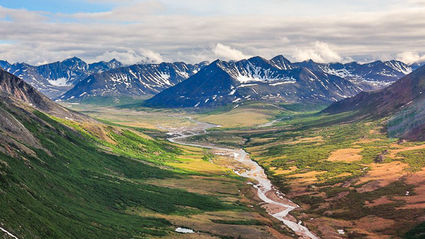Stan Foo named Graphite One Alaska COO
North of 60 Mining News – June 15, 2018
Last updated 9/25/2020 at 5:26am

Graphite One Resources Inc.
A view of the Graphite Creek project in northwest Alaska, where Graphite One has outlined roughly 5.7 million metric tons of graphite along a portion of the 11-mile long trend of near-surface mineralization identified there.
Graphite One Resources Inc. June 11 named Stanley Foo as chief operating officer of the company's wholly-owned Alaskan subsidiary, Graphite One (Alaska) Inc.
With more than 35 years in the mining sector, including 21 years in Alaska, Foo has served as president and general manager for Donlin Gold LLC, general manager for Alaska Gold Torrent, chief geologist and general superintendent for Cortez Gold Mines (Nevada) and project manager roles with Placer Dome and Barrick Gold Corp.
He also served as mining section chief at the Alaska Department of Natural Resources and is widely respected for his ability to build durable working relationships with state and federal regulatory agencies and Alaska Native stakeholders.
This long time Alaska and mining experience will be an asset as Foo leads Graphite One's Alaska operations out of Anchorage.
"Stan's appointment adds an experienced mine developer and operator to our Graphite One team," said Graphite One President and CEO Anthony Huston. "As we move into the next phase of development, adding an accomplished COO, with deep experience in Alaska mining is critical for us."
Graphite One is advancing plans to develop a mine at its Graphite Creek deposit on the Seward Peninsula in western Alaska and a processing facility that would refine the graphite concentrates produced there into the coated spherical graphite used in lithium-ion batteries and 13,500 purified graphite powders for other applications.
Located about 35 miles north of Nome, Graphite Creek is the largest known deposit of graphite in North America.
Systematic drilling of only a small section of the 11 miles of known near-surface mineralization at Graphite Creek has outlined 10.32 million metric tons of indicated resource grading 7.2 percent (744,000 metric tons) graphitic carbon and 71.24 million metric tons of inferred resource at 7 percent (4.97 million metric tons) graphitic carbon at this deposit.
The unique characteristics of the material at Graphite Creek makes it well suited for being transformed into coated spherical graphite, which is used as an anode material in the batteries of electric autos.
A preliminary economic assessment completed early in 2017 outlines plans for a mine at Graphite Creek and an off-site facility to refine the graphite that would produce 41,850 metric tons of coated spherical graphite and 13,500 metric tons of purified graphite powders annually.
Graphite One is hoping to find a place in Alaska to set up the advanced material processing facility and is working with Alaska Industrial Development and Export Authority (AIDEA) to find an Alaska locale that meets the requirement for such a plant.
A preliminary search by AIDEA identified four Southcentral Alaska locations – Homer, Kenai, Port Mackenzie and Seward – that meet the criteria and "are very interested in discussing this project with Graphite One management."
Known as the Graphite One project, this proposed mine and processing facility would help provide a domestic source of this increasingly important ingredient.
Graphite is among the 35 minerals the United States Geological Survey identified as critical to the United States.
One of the reasons the USGS considers graphite critical is the growing demand of this mineral as anode material in the lithium-ion batteries that power electric vehicles and a rapidly expanding number of personal electronic devices.
The other major factor playing into graphite's criticality it that the U.S. is fully reliant on foreign countries for its supply of this battery ingredient.
According to USGS' annual report, "Mineral Commodity Summaries 2018," there are currently no domestic sources of the graphite used in the United States, which resulted in domestic manufacturers looking abroad for the roughly 50,000 metric tons of the carboniferous material used in the United States during 2017.
USGS sees a major spike in U.S. demand for graphite when Tesla Motor's Gigafactory, an enormous lithium-ion battery facility being constructed in Nevada, is fully operational.
"When the plant is complete, it will require 93,000 tons of flake graphite to produce 35,200 tons of spherical graphite for use as anode material for lithium-ion batteries," the USGS inked in its report.
The geological survey listed Graphite Creek among two potential domestic sources of graphite.
"Development of the company's high-quality graphite resource has the potential to create an important strategic asset for the United States, a key ingredient for a clean energy future and a potential economic engine for the Seward Peninsula and Alaska," said Foo. "It is the right project at the right time in Alaska, a jurisdiction that is supportive of mining."
In addition to his professional career as geologist and mine developer, Foo is active in Alaska trade organizations and advisory groups including Alaska Miners Association, Resource Development Council for Alaska and BLM Alaska Resource Advisory Council. He also serves on the board of the Iditarod Trail Committee, which organizes and oversees the Iditarod Sled Dog Race from Anchorage to Nome annually.
"(W)ith our proposed mine and processing facilities potentially creating substantial employment, we expect Stan to be followed by many more Alaskans joining Graphite One as the project advances," said Huston.
–SHANE LASLEY














Reader Comments(0)